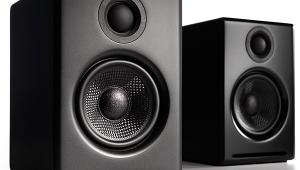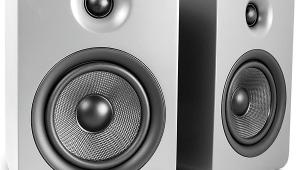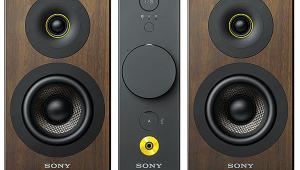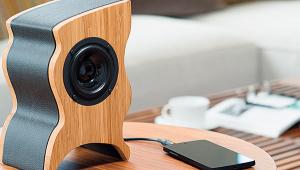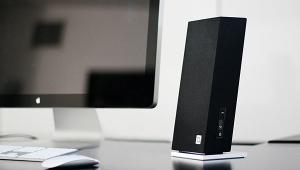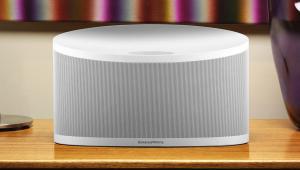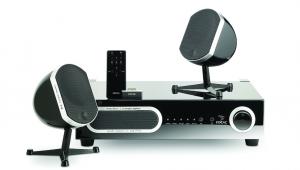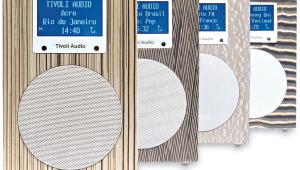Audioengine 5 Amplified Speaker System
The increasing iPod-centricity of the audio industry has not prevented one brave manufacturer from releasing a product without the omnipresent iPod dock. Why would Audioengine do such a thing? Their Website explains: "There are so many iPod-dock products on the market right now, so we made a decision early on to spend our development budget and time on audio quality and other features (like USB charging). We feel that Apple docks are the best, so why waste resources trying to redesign a nearly perfect dock? We were also able to keep Audioengine pricing much lower without integrating a 30-pin dock system."
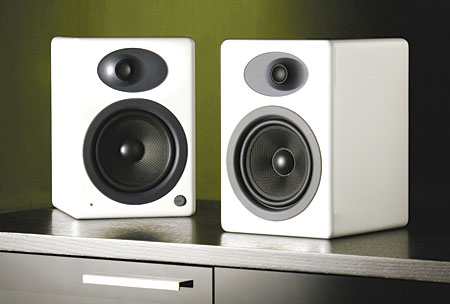
Notwithstanding, some folks who seek home ports for their iPods may dismiss the Audioengine 5 as an also-ran, a curiosity, a mere footnote in the history of the Apple steamroller. They shouldn't. This is a great-sounding system.
Power and Substance
Powered speakers—that's the briefest description of the Audioengine 5. The two speakers come only in white. (I wonder why.) They are larger than most desktop speakers but smaller than many monitor or bookshelf speakers, and they are made of better stuff than the puny multimedia (ha!) speakers on the shelves of your local computer store. Inside the high-gloss, 1-inch-thick MDF enclosures are 1-inch silk dome tweeters and 5-inch Kevlar woofers powered by 45 watts per channel. The tweeter is recessed into an asymmetrical waveguide that makes the speakers, together, look reverse-cross-eyed.
The left speaker receives the power connection and uses speaker cable to feed the right one. A blue LED resides in the left speaker's lower-left corner. In the lower-right corner is a volume knob. Turning the volume knob all the way counterclockwise reduces the volume to nil but does not turn off the system. A switch on the back does that.
There are two ways to connect your music sources. A 30-pin iPod dock is not one of them, unless you add the Apple-made accessory dock. But there are two 0.125-inch minijacks, one atop the left speaker and one on its back panel. If you just can't get over the sight of a plug jutting out of the top of the speaker, you can always use the back connector. My desk always looks like a disaster area, so I didn't hesitate to use both.
The top minijack shares a tiny subpanel with a USB connector. This lets you recharge various players that receive power via USB, but it doesn't provide for the transfer of audio or data. Of course, that would include the iPod, as well as other players that work the same way. The left speaker's back panel also includes an extra power outlet and wire-clip output terminals to feed the right speaker.
Supplied cables include 18-gauge speaker cord to link the speakers, two 10-inch interconnects with miniplugs on both ends, a 72-inch interconnect, a male-mini-to-female-RCA stereo-adapter cable, and a 41-inch USB extension cord. Audioengine supplies the two 10-inch cables to connect both an Apple dock and an AirPort Express. The long cable enables relatively long-distance iPod use (from your hand to your bedroom table, say). I used it to span the full width of my desk, reaching my IBM ThinkCentre PC. Even while the minijacks are busy, you can recharge your player simultaneously, using the USB jack, without powering up a PC. The USB extender combines with the long interconnect to facilitate simultaneous long-distance playing and charging.
The mini/RCA adapter cable could mesh with stereo output jacks from a larger component audio system. However, Audioengine says the designers were thinking more of stereo TV output, taking advantage of the TV's remote control. Other prospective mates include a video-game console, a mobile phone, a satellite receiver, or a DVD player, in addition to the Apple Universal Dock and AirPort Express. Please note that, to use the Apple dock, the signal still has to go through one of the Audioengine 5's analog minijacks, eliminating the docking connector's potential digital sonic advantage.
Despite all of these options, once you get these round-cornered beauties out of their drawstring bags and figure out how you want to use them, it only takes seconds to get the system running. However, if you've never had a really great pair of speakers sitting on your desk—or beside your bedroom TV, for that matter—it might take some experimentation to find the perfect spot for the Audioengine 5s. The manufacturer recommends keeping them 6 to 12 inches from the wall, which is enough to provide some acoustic bass reinforcement while not going overboard. I placed them 18 inches out, on either side of my PC monitor. Some of my listening was in the near field, but most was from an armchair across the room.
Naked Aggression, Mad Experimentation
I fired up the Windows Media Player with Let It Be...Naked, the Paul McCartney remix of Let It Be. The lead track is "Get Back," the nasty song McCartney wrote about Yoko Ono. (He should be ashamed of himself.) Since the speakers have no grilles, I could see the woofers trembling under the load of Sir Paul's Hofner bass. I reached out and touched a fingertip to the right woofer, and the bass traveled through my finger and up my arm into my shoulder. That's bass. It's not quite the steroidal bass of the Apple Hi-Fi, but, during the selfishly pleasurable month I've spent with the Audioengine 5 system, I've felt no need for a sub. When the volume goes up, the bass goes up with it. On the live version of "Why Can't We Live Together," from the U.K. bonus disc of Steve Winwood's About Time, Winwood plays the bass part with his left hand on a Hammond organ. It's a blander kind of bass, without Sir Paul's distinctive touch, but at least the Audioengine 5 keeps it in proportion. I've played this track on every iPod-mate that's come through here, and I find that most systems tend to bend it out of shape, making one or two notes leap out brashly while underplaying the rest. Bass is nice. Proportionate bass is even better.
Kid A by Radiohead starts off with an ominous electric-piano riff. The first time I heard it, I followed the sound into an adjoining office and asked the flash animator who works there, "What's that?" The Audioengine 5's silk dome tweeters do wonders for Thom Yorke's whiny voice, keeping it adenoidal but—well, silky.
The Audioengine 5 was designed expressly to work with compressed file formats. So far, everything I've thrown at it has been MP3 at 192 kilobits per second. That's better than most downloads (128 kbps) but is still compressed. There's only so much magic even a clever little system like this can work when useful data has been thrown away.
For instance, Carlos Kleiber's version of Beethoven's Fifth Symphony doesn't capture the distinctive character of the world-class Vienna Philharmonic. I've heard an orchestra (not the Philharmonic) play in the Vienna Musikverein, and there's a golden glow and a spatial aspect to the live experience that's absent here. However, the Audioengine 5 musters the next best thing, a sweet smoothness. I let the first movement play through and then repeated the track straight from CD with a Rotel RCD-965BX Limited Edition CD player. This gives the strings more of a cutting edge, but the feel is still digital—and not as pleasant. Then comes the mad experiment—the same track on 30-year-old vinyl, played on a venerable Luxman turntable with a new Shure V97xE cartridge, using the phono stage of my Onix OA-21S desktop amp via the tape output.
How I wish I could say it sounded like the real thing; what a great story that would make. But nothing ever does, short of buying a ticket to a concert at the Musikverein. What I did get was greater comfort than in either of the digital demos, compressed or uncompressed, including a sense of freedom to turn up the volume.
Back at my desk, I stared at the turntable sitting next to the Audioengine 5's master speaker. It was playing the second movement. Now that I was sitting right up against the speakers, I heard something else—it was the Musikverein! It was faint and not nearly as vivid as the real thing, but, yes, there were the walls. The vinyl did have a secret to tell after all. What a wonderful surprise this will be for the Audioengine people. I flipped the disc and played the rest.
Compared with the Apple iPod Hi-Fi—as this product inevitably will be, since it's aimed at the same market and is identically priced—the Audioengine 5 has one crucial advantage. It is equally suitable for desktop or across-the-room use. Changes in listening distance or the vertical position of your ears have relatively little effect. The Hi-Fi, on the other hand, was carefully and deliberately designed as a nondesktop system and is less consistent close up. Of course, the Hi-Fi has the dock and is far more portable. Both have superb bass.
I never watch movies on my 17-inch, 4:3 desktop monitor, so I can't say that I've fully explored the Audioengine 5's multimedia prowess. But, when I leave the volume up, the Windows operating system noises scare me.
Bohemian Chic
Even if you do not go to the extreme of hooking up a turntable, the Audioengine 5 is still smart enough to find the oasis in the MP3 desert. As billed, it's well suited to compressed music formats, not only getting good bass out of them, but a pragmatically sculpted midrange, as well. It's also revealing enough to get the best out of better signal sources, up to and including analog. And the speakers look as beautiful as they sound, quirks and all. If you want your desktop to exude bohemian chic, the Audioengine 5 is my current favorite choice in desktop music systems.
* Audio editor Mark Fleischmann is also the author of the annually updated book Practical Home Theater (www.quietriverpress.com).
Highlights
• Portable powered speakers designed for MP3 players
• Smooth midrange and serious bass
• Idiosyncratic and provocative
